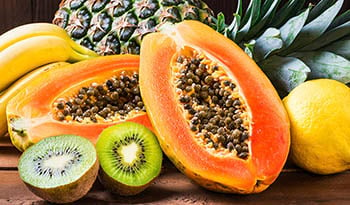A Pediatrician’s Guide to Vitamins
DISCLAIMER:This blog does not intend to provide diagnosis...

As a board-certified pediatrician, I’m often asked which supplements or multivitamins I recommend for keeping babies and tots healthy. There are a few essential vitamins that I always recommend, and I’ve created this guide to help you provide your infant or child with the best supplements to complement a healthy diet.
Vitamin D
Since levels of sunlight exposure needed to produce vitamin D may increase the risk of skin cancer and because dietary sources of vitamin D are limited, supplementary vitamin D is essential for infants, children and adolescents. It is especially important for exclusively or partially breastfed babies. The current American Academy of Pediatrics recommendation states that all infants and children should receive 400 international units of vitamin D per day starting shortly after birth.
Formulas sold in the United States have at least this recommended amount of vitamin D, so no supplementation is needed if your baby is drinking at least 32 ounces of formula a day. For other children, I suggest using California Gold Nutrition baby vitamin D3 drops since they are free of GMOs, gluten and soy, and are made with all-natural, fractionated coconut oil. These drops do not contain unwanted preservatives and they are safe and effective. By using these vitamin D3 drops you can help protect your child against rickets, a condition caused by inadequate vitamin D intake and decreased sun exposure that is characterized by the softening and weakening of bones.
Vitamin C
Vitamin C, also known as ascorbic acid, plays an important role in immune health, as well as wound and bone healing. It is an antioxidant and helps with iron absorption. Children eating a varied, balanced diet are very unlikely to be vitamin C deficient, but tobacco-smoke and nicotine exposure can increase the vitamin C requirement up to 40%, which is important to keep in mind. The recommended daily allowance for vitamin C varies by age and increases once your child turns 14 years old. Vitamin C deficiency, although rare, results in a condition known as scurvy, which leads to poor wound healing, joint pain and sometimes bleeding of the gums. If you and your pediatrician decide that your child may be at risk of vitamin C deficiency, I recommend using California Gold Nutrition’s Children’s Vitamin C. The natural orange flavor is appealing to kids, which is important. Additionally, this formula is gluten free and non-GMO. Always be sure to discuss the appropriate dose with your pediatrician so that you do not provide an amount above the recommended daily intake.
DHA
DHA, or docosahexaenoic acid, is a long-chain omega-3 fatty acid that is essential for normal brain function. Although studies are still limited, researchers have shown improvements in cognition and behavior as a result of DHA supplementation. If you and your pediatrician decide that DHA supplementation may be beneficial for your child, be sure to check out California Gold Nutrition children’s DHA chewable vitamins in strawberry-lemon flavor. California Gold Nutrition also has a Baby’s vitamin D3 and DHA combination supplement, which is particularly useful if your child requires vitamin D supplementation and you’d like to start DHA, too.
Multivitamins
Introducing a multivitamin once your child is older can be an effective way to continue guaranteeing adequate nutrition. Most children who eat a balanced diet do not require vitamin supplementation, but for picky eaters or those who do not like to drink milk, a multivitamin can be extremely beneficial. California Gold Nutrition kid’s mixed berry multivitamins are a great option that I often direct parents to since they contain no gelatin or gluten. I always remind parents to be sure to keep these vitamins stored in a safe place and to always remind the child that the vitamins are medicine and not candy. Megadoses of vitamins can be toxic, so it is extremely important to monitor your child when he or she is taking his or her daily multivitamin.
References:
- http://pediatrics.aappublications.org/content/122/5/1142
- https://www.ncbi.nlm.nih.gov/pmc/articles/PMC3738999

 By Dr. Cherilyn Cecchini, M.D.
By Dr. Cherilyn Cecchini, M.D.


